![]() You don't need to be an 'investor' to invest in Singletrack: 6 days left: 95% of target - Find out more
You don't need to be an 'investor' to invest in Singletrack: 6 days left: 95% of target - Find out more
I’m 47, I was previously an accredited CSWIP Weld Inspection. I am a Fellow of the Institution of Mechanical Engineers. I have project managed numerous big pipe work installation and refurb jobs (including complex remote welding in nuclear reactors). My father was a blacksmith and steel fabricator.
I’ve never picked up a welding torch in my life!
But always wanted to learn so I can do the odd job around the place.
What’s the best thing to do, pick up a MIG set, a load of steel offcuts and YouTube or should I try and find a night class? I’ve had a quick Google and all I can really find locally are coded courses / qualifications but sure there must be some sort of numpties class about with a bit more research….
Can anyone in your industry not teach you? I had contract pipefitters on site a few years ago and had the awesome old fella teach me the basics. I then spent loads of company money on a nice water cooled Lincoln AC TIG set and hours of wasting company's argon.
Gas cylinders are the issue with DIY/home MIG/TIG.
Is there a local 'Men in Sheds' group or similar? Not specifically welding, it's basically old guys who know how but are no longer capable teaching young guys who are capable but don't know how all kinds of useful things
Why MIG in particular? Why not just electric arc as a starter? Or a torch and filler rod? God knows that's hard enough. I had a brief go at TIG which was a bit like holding a dentist's drill compared o other welding. I was pretty crap at all forms of the art though. Oh and brazing.
Go n buy a 151 mig from machine mart. And a full size bottle n reg.
Just practice.
Ps mig welding forums a good place too
Where abouts are you in the country. Hinkley point are crying out for welders, and because of that there are free welding courses on offer in Bridgwater.
Following on from my post above - I've become really quite proficient at TIG welding through practice, YouTube and mithering the pipefitters when I have big projects on.
I must say TIG welding is one of the most relaxing and rewarding acts of mindfulness that Ive ever done. Having to fully concentrate and have both hands doing exact movements coupled with a foot operating an amp pedal really blocks out any background noise that might have been filling my head before I sat down at my bench and fired an ark up. I don't think I'd feel the same if it was my full time job though!
But always wanted to learn so I can do the odd job around the place.
what ‘place’? Your home or your place of work?
presumably we’re not talking about odd jobs that lives or livelihoods depend on
Welders are petty easy to operate - turn on, twiddle dials, pull trigger. Less easy to grasp is what the outcome should be - but you already know that bit. If you want to do odd jobs then you need to have the welder anyway whether you decide to do a course or not. So given you have an understanding anyway just buy something and play with it. If you’re not satisfied with the outcome after you’ve had a bit of practice then sign up for a course- but unless you need a qualification out of it I doubt there are many courses they would be better than some of the better thought out youtubers - not least because the camera can actually watch what’s going on.
it’s worth bearing in mind though that the welder is only one of the tools you need - until you also have the tools to cut, prep, manipulate, support, clamp and finish whatever you’re making then the scope for doing ‘odd jobs’ is limited.
I bought my first welder with an unexpected £300 tax rebate after I left college. Id say it was about 15 years and several grand of other odds and ends before it became a genuinely useful tool
I did an introduction to mig & tig course at the local college.
Really enjoyed it and got to play with the expensive college toys. They were so much better than the gasless mig I was given by a mate who'd bought a cheap one to self learn and had given up.
If I was learning I'd go with stick to be honest. I've not welded in years but I used to do a load of TIG and stick with little bits of MIG and brazing. It also depends on if you have a plan of making things once you do learn or if it's just an itch that needs scratching as this would also determin what to buy so you dont end up buying two sets.
I started off with one of these. A flux core mig.

It was pretty frustrating. Produced messy, porous welds.
Sold it and got one of these...
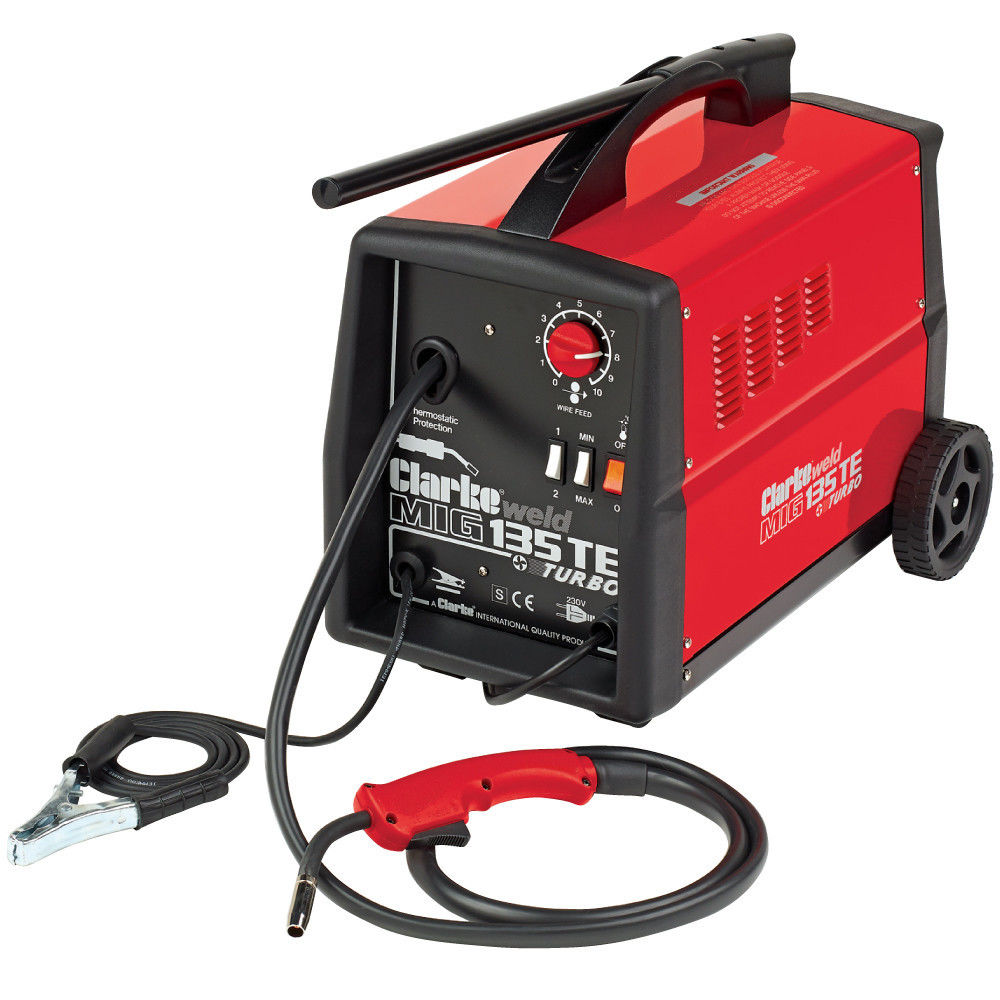
Which is so much better.
Takes small gas bottles but you could get bigger.
I ended up doing an evening class and got a basic qualification but I found that the actual instruction on the course wasn't great. It basically gave you practise time and you figured it out yourself, and that's really what you need.
I don't get the welder out that much so have to relearn every time I do.
Enjoy it though.
torch and filler rod
is a good way to put someone off. I was a nervous wreck by the time I finished oxy-acetylene welding, having work pieces explode and launch themselves over your shoulder and set fire to the floor behind you is not in any way relaxing or mindful. It was either that or constantly sticking the rod.
Stick was alright, I could do functional if not pretty welds, wouldn't trust myself to do anything structural without doing a proper course though.
Thanks folks.
No longer so close to any hands on work at site plus they’re not keen on amateurs having a play on nuclear licensed sites. Even if it is just in the workshop. I do regret not asking one of the welders years ago for some instruction though.
As for what jobs - around the house etc. We’ve got a fairly rural place, few acres of land. Main gate has been hanging off its hinges for a fortnight as I’m waiting for a pal to turn up and do a 10 min welding job. That kinda thing.
Welding is easy. Metal prep is harder. Get a mig and get cracking.
. It was either that or constantly sticking the rod
Haha that's pretty much how I remember my welding when I was on a teenager on a YTS in the 80's!
In my opinion, what you want to weld will determine what set you need to start off on. Have you got thin panels or thicker section stuff like plate or box section? If its the thicker stuff I would get a MIG set, easy to use, cheap to run, etc.Also arc sets are good for this, but its 25 years+ since i did any arc welding so I would stick with MIG. Something to consider though is the filler rod issue.
If you want to weld a variety of materials then you will need to have a variety of rolls of MIG wire to accomodate. This can get expensive ,especially if theyre sitting around rusting most of the time. Rusty filler wire gives shit welds .In this scenario, arc or tig is better better because you csn buy small amounts of rod, just enough to do the job you need doing, without having a useless surplus.
If you have a need to weld very thin section material or do things like put hard edges on tool edges, etc, then TIG is the way to go, its more versatile as it will do both but as mentioned, getting hold of argon shielding gas at a reasonable price might be tricky. And, if you want to weld aluminium, you will need an ac/dc set which pushes the price up again.
As far as learning resources go, I have taught people to tig weld to a reasonable standard in as little as an hour, and I'm not particularly experienced. Its not difficult to pick up if you have someone half decent supervise you.
If youre learning alone, I can recommend Welding Tips and Tricks, hosted by Jodie on Youtube. Produces some very decent videos which helped me a lot with little things here and there.
Hinkley point are crying out for welders, and because of that there are free welding courses on offer in Bridgwater.
Couple of hours in the evening and you'll soon be working on Ex Class 4 projects .
You'll be able to drive up there on your Kellogs HGV licence 😉
I had a stick welder which was horrid and I never got good welds. I then got the second one that Kayak shows above and it is okay. Have welded gate brackets, art pieces and various other stuff. I wouldn't use it for life and death jobs but am happy with around the house sort of stuff.
Make sure you have a good grinder to clean up the bird shit weld finish
No one asked what metal inside or outside? Up to 4mm mig all the way after arc is better. Stainless and ally it's Tig all the way.
Don't get a machine that will do it all because they won't. Avoid second hand when starting out as the machine could be on its way out and you don't want the wire sticking in the lines or gun when starting out. Mig weld forum is very good.
Those clark machines are top value.
I like the slightly larger 151 as its just got a bit more in reserve but it's all depends on what your glueing together
As for what jobs – around the house etc. We’ve got a fairly rural place, few acres of land. Main gate has been hanging off its hinges for a fortnight as I’m waiting for a pal to turn up and do a 10 min welding job. That kinda thing.
Just get a decent branded basic arc/stick welder. Perfect for welding outdoors without the hassle of trying to shield the gas and also where the steel or prep isn't 100%. Keep the rods dry in storage and it'll always be ready to go.
I'd avoid cheap MIG with crap wire speed control as well as needing a bottle that will no doubt be empty when you need it plus the joy of having weld spatter fizzing in your ear....
TIG is too expensive for very occasional homestead repairs.
Big agri farm stuff is arc all the way. From 2mm up when you get to grips with it also you can get different rods but keep them dry and warm before use
Don’t get a machine that will do it all because they won’t.
The higher priced units do... very well in some cases . Parweld XTM 211Di will do HF AC and DC tig as well as mig and stick.
You are up over £1500 , but its night and day comparison to a cheap unit.
I have 2 Esab Rebels, but they only do lift Tig but are great Mig and stick welders
Interesting, in my 20s I taught myself MIG welding for fixing up cars. One of my mates was a welding inspector so had a good laugh at my welds but they got better quickly. I used CO2 from a pub bottle as shielding gas - it was OK for the simple repairs I was doing and e.g. making a trailer.
I had access to a MIG setup which was nice to use but I never did anything hard with it.
So, I'd like to try again and saw the mention of evening classes. Looked up Bucks Council. No metalwork classes at all - no welding, basic lathe work, nothing. Closest is beginners woodwork 🙁
Get a MIG machine and some offcuts of different thicknesses, reality is the big things you learn are prepping the material (cleaning it a bit, grinding them down if doing V welds and so on), then just practice, two big things is the feed speed and voltage, this is something you can practice line after line, you'll know if the voltage is not good, you'll either get not enough, or too much penetration of the weld into the material, so either a line of bird poo, or a weld that's sunk into the material a bit too much, or on thinner material the nightmare hole appearing and getting bigger no.matter what!
Once you get the feel for speed and understand the settings you can then hit other materials, steel's the easiest, aluminium can be harder, you'll need new wire spools for other materials and so on.
As for other suggestions, Oxy-Acetylene is pretty rubbish and for car garages and brazing, Stick Welding (Manual Metal Arc) is just dirty and not fun, too much pollutants due to the flux and a lot of cleaning after every weld, and of course you can only go as far until you have to replace the electrode (and chip and clean the slag!), MIG is nice and easy and just a really good general welding process, MIG is a bit finer and requires more training and effort, stick with MIG for now.
Also, get some kit, extractors are essential, as are mask, gauntlets and overalls, have seen a few sufferers of arc eye and a scottish welding tan in the past!
Definitely need to weld outside at times (but do have a decent workshop for majority). Does that rule out MIG? Unlikely I’ll ever need to weld anything other than mild steel, and not any thin sheet. If I even need a stainless or ali job doing I’ll find an expert.
TIG is lovely to watch when done properly - seen some very skilled welders produce beautiful welds on stainless but ruled it out for what I need.
Oh and plenty of workshop / prep stuff already. Angle and bench grinder, flappers etc so not a problem putting a decent prep on stuff.
Having made my living doing just that for about a decade (a long time ago though)
i would say
learn to TIG weld
everything else is just spitting hot drops and hoping it sticks!
For anything outside get a MMA (stick) set, small and portable. I'd probably get a Clarke 151 mig (i did) not long after if I wanted to do anything indoors (get argon/co2) mix. Easy enough to teach yourself either and the second one is much quicker to learn as the principles are the same. Passed city and guilds MMA in half a day after self taught, but had to turn up for the other 4.5 day,so played with Ali Tig a bit. That's hard scratch start without a pedal!
Another vote for TIG.
It is arguably the hardest process to get to grips with but it is, in my opinion, the most rewarding. Also, a TIG machine will also do MMA (stick) whereas only a few MIG machines will do so. Conversely many contemporary MMA machines will do 'lift' TIG to an extent. I have a Lorch MicorTIG, an absolute joy to use. Also have a
Böhler Uranos MIG.
I was fortunate enough to be able to do an evening course on TIG welding at the local college and it was the best £250 I've spent.
Interestingly I was talking to a mate’s 90 year old Dad who worked (iirc) at ICI on Teesside, he said they were surrounded by brilliant engineers, he’d have swapped ten of them for one good welder!
I realise that little vignette contributes nothing to the discussion other than to stick to your desire (having said that I’m not an engineer and I can’t weld - so I’m just an old fart telling someone to do something I can’t do myself😀)
I taught myself with a mig a few decades ago. Initially it was only for car restorations. But ended up doing all sorts of jobs. I also bought am arc welder for heavy jobs.
The biggest thing that helped me was understanding the science of a weld.
Funnily enough I might drag it out again soon, as we're after a vintage car to travel to all our rock and roll gigs and dances. Off to look at a Ford 36 Sedan
The biggest thing that helped me was understanding the science of a weld.
Then I should be OK! 😉 The CSWIP Welding Inspector course I did years ago goes into loads of detail on metallurgy, weld prep, theory, inspection etc. It just didn't require you to do any welding...
Leaning towards picking up a stick set and load of scrap. What I need will definitely be at the more agricultral end of things and may occasionally need to be done outside so makes more sense I think.
In general the older you are the more you will struggle to see what you are doing when learning.
Old welders get by on experience.
There are some high frequency start inverters for under £250. Would need more investigation as I've no idea if they are any good, but would maybe let you do stick now and (proper not lift start) TIG later.
I haven't done any welding in well over 20 years, but personally I would start by learning oxy-acetylene welding and brazing. This will familiarize you with how metal melts and flows and the coordination you need for any welding.
If you're going to be doing heavy stuff (structural steel, etc.) stick welding would be the next thing I would learn. Stick welding is easy when you can do it on the flat, vertical and overhead is much trickier because the metal want to flow downhill. I could just manage a competent vertical weld, never even bothered trying overhead welding.
If you learn those two, MIG is very simple. The problem with MIG is it's very easy to get a nice looking weld with poor penetration. If you want to do panel work on a car, MIG is the obvious thing.
I've tried TIG, but it's a lot trickier IME. I didn't persevere long enough to get any proficiency, it just seemed like oxy-acetylene welding with less heat, so getting penetration was more difficult. For what I was doing at the time (rusty old cars and farm equipment), an oxy-acetylene set and a stick welder were fine so I couldn't be bothered persisting with TIG. Dumb mistake.
To be fair, if it's only mild steel he's playing with, TIGs a bit fancy for that, especially if it's good sized fillet welds on plate, loved TIG for exotic materials and of course welds that are visible and look great, but i guess if learning and wanting to reach a good level, TIG is the one to aim for.
Stick is just awful though, industrial welding that's just a boring slog with lots of mess and cleaning, not much progression with that stuff, but you can get a job in the oil and gas sector, or agriculture easier!
so getting penetration was more difficult
torch angle, tungsten ground to a sharp point laterally (ie inline) as little gas flow as required (it has a cooling effect), and whack the amps up! I have a foot pedal on my 300amp Lincoln and generally leave it on full to give you plenty of heat on the cold start of a weld and then gently reduced the amps to keep the HAZ spread equal along the weld as the piece heats up. It's easier than trying to speed up your weld travel speed as the heat increases.
I started this time last year after realising being able to weld is a huge capability upgrade.
Started on stick (MMA) (R-tech 135) which is a superb bit of kit - no sticking, starts easily, weighs nothing (inverter not transformer). You can do a surprising amount with it (and an angle grinder if it gets messy).
+points: minimal steel prep, will weld through millscale & rust, no gas, easy to access difficult welds, can weld outside in the wind
-Points: Messy, requires cleanup, slag everywhere, smokey, less than 2mm steel thickness is hard. Steel prep in terms of "fit" is important - a gap between the two bits to weld will result in bad times.
You'll quickly realise you'll need a few things like chop saws, angle grinders, steel benders to make the most of metal work, here are a few things that I've made using MMA/Stick.
Welding table - that's the first thing to do
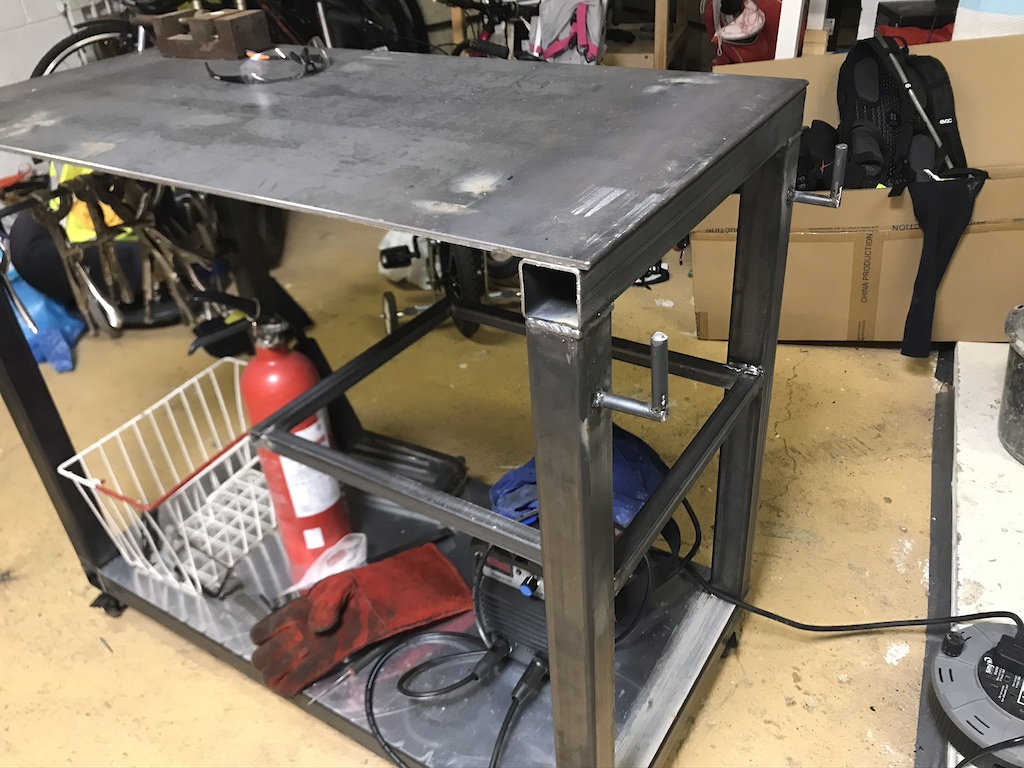
WFH office desk, inspired by CV19


Garden steps
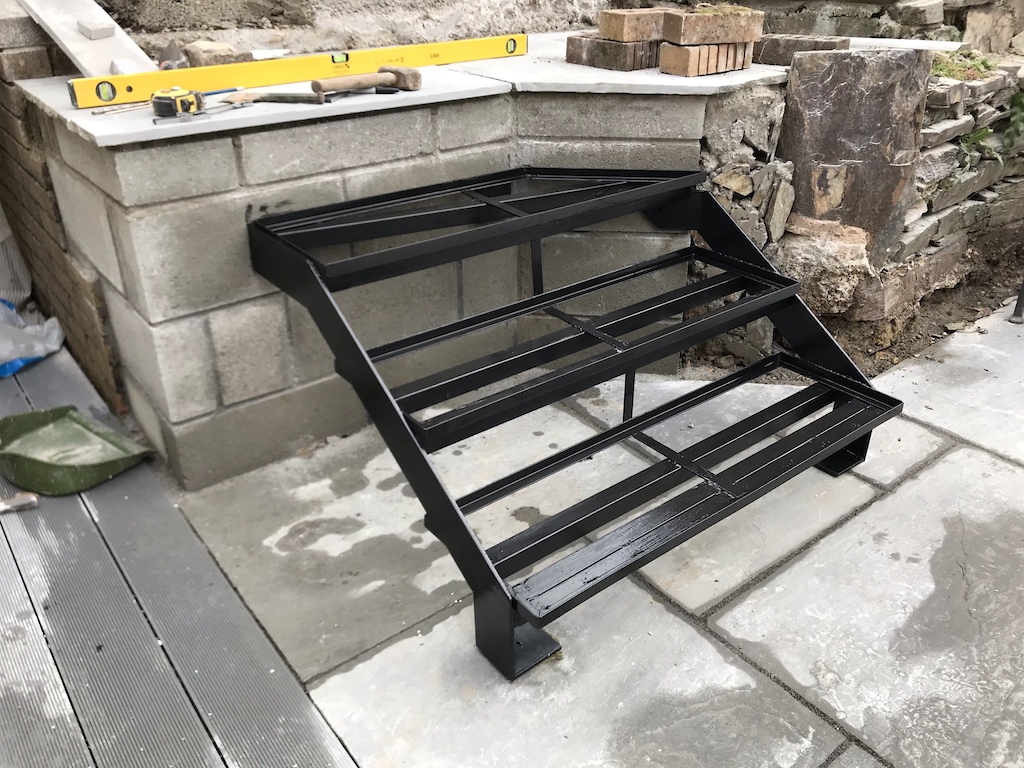
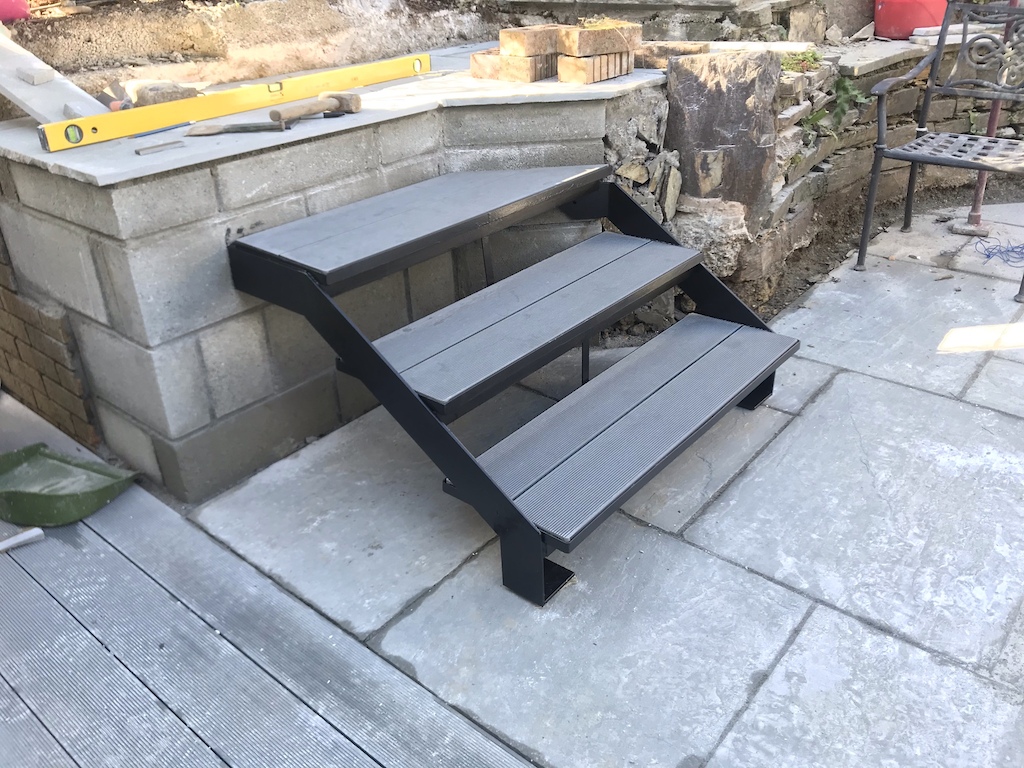
Rounded crank bolt removal
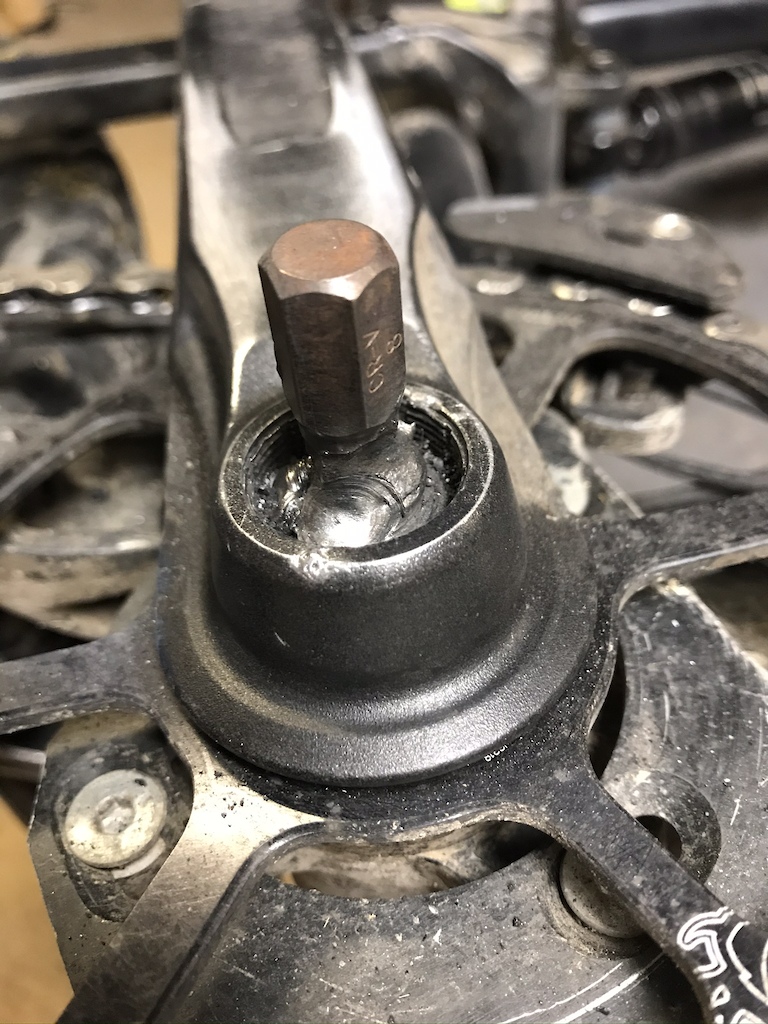
I then progressed onto TIG as my mate kept going on about how it's the future etc.
Whilst it does produce very nice welds and is a nice process, material cleanliness is critical.
+points: looks great, very clean relaxing process (no sparks or slag flying off everywhere), you can 'fuse' stuff together without any extra filler rods etc, can do other materials (Stainless)
-Points: Material prep, can't really do it outdoors, needs gas (pure Argon)
A few things using TIG
Bracket for a TVR (S Series) bonnet hinge Mod.

Piece for a table - this is fused, so the weld material is from the parts melting together

Bike Packing panniers - 10mm SS tubing, 1mm wall thickness. This was a pig to do tbh.

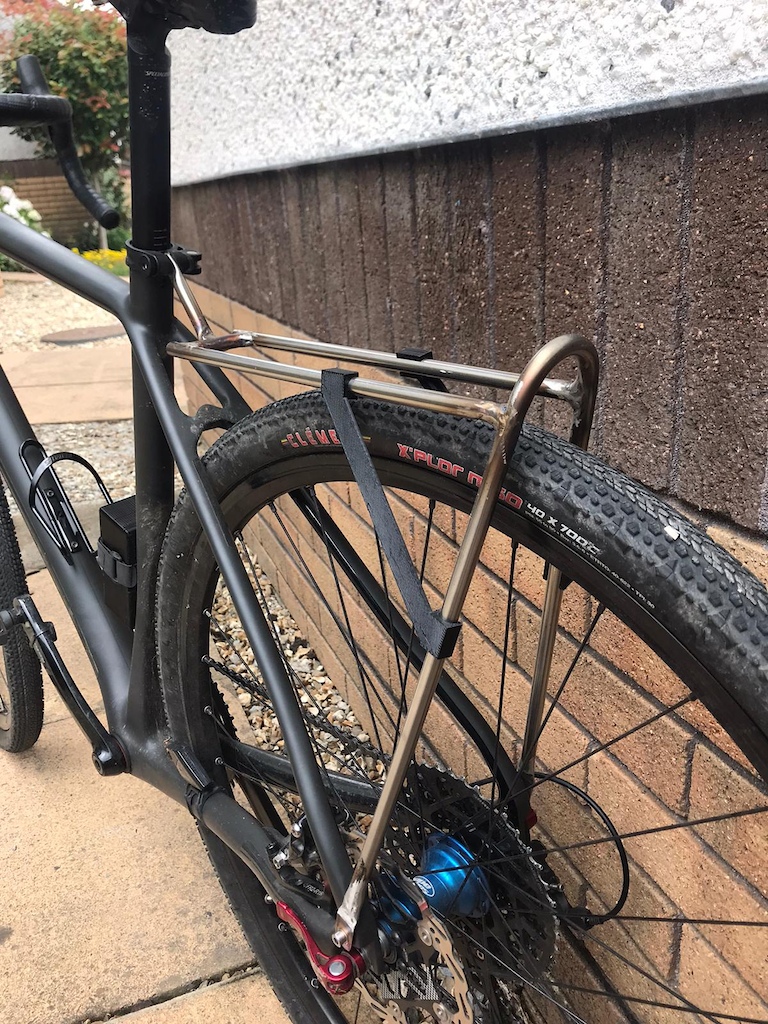
And a couple of weeks ago I thought I'd give MIG a go, I'd liken it to using a hot glue gun, quite easy to get the hang of, not as messy as MMA/ARC but not as nice as TIG.
+ Points: Easy to get the hang of, no mess (if using gas), less material prep than TIG or MMA, can weld thin metal (car body etc)
- Points: Bit of a faff (wire spool feed etc), needs gas (CO2/Argon), weld penetration not as good as MMA
As you can get away with pure CO2 for MIG (C02/Argon mix is better depending on what you're trying to achieve), I've rigged up a fire extinguisher setup for the gas (I have a good supply of out-of-service extinguishers), which I've worked out will give about 20mins of continuous welding (at 10 litres per minute) - note it's upside down as CO2 extinguishers have a dip tube to dispense liquid CO2.
I made the stand using MIG, which is the only thing I've done so far. I'm definitely sold on it for quickly knocking stuff up that doesn't have to be aesthetically pleasing.
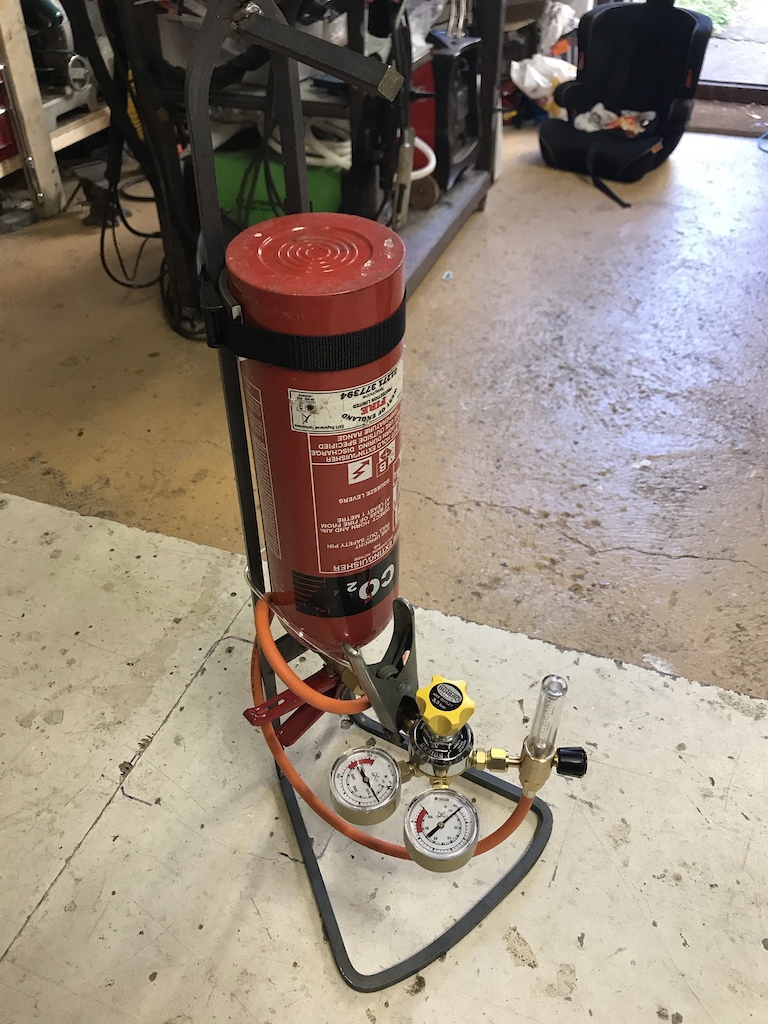
I think you need to decided what you'll want to be doing with it, but you'll be surprised what you can do with a little MMA/ARC Machine (and an angle grinder to clean up...) to begin with.
More stuff here: https://www.pinkbike.com/u/mikeyd/album/Welding2021/
@thols2 I wouldn't touch oxy without proper instruction. Gas mix and knowing how much to heat are critical and just end up with a dangerous mess if you get it wrong.
Acetylene is also something I'd rather not have around if I could help it, that's a safety lesson on its own.
Using it for gas axe duties though, that's easy. And fun.
Using it for gas axe duties though, that’s easy. And fun.
My thinking is that you'll always have an oxy-acetylene set around for gas axe duty anyway, so you might as well learn to weld and braze with it. Yes, you need to learn how to use it properly to avoid a nasty death, but the same goes for a lot of stuff in a workshop. Taking some night classes is well worth it.
@mikeyd - that's a very helpful post and some very tidy looking TIG work!
To be honest, I'm pretty sold on MMA / stick for what I need, even though I like the idea of TIG. Knocking together a few lumps of mild steel here and there is all I realistically need.
You can pick up a reasonable (but agricultural) stick welder pretty cheaply so you can have a go and see how it works for you without much investment. I still get my old stick welder out for certain jobs as it has its place.
I taught myself MIG years ago when rebuilding our old VW camper. I was very successful in sticking metal together, less so with controlling distortion!
I had a hankering to learn TIG and in a flurry of pre-bre*it spending, bought myself a decent imported AC/DC set (Sherman 206P - no longer available in the UK). It’s a steep and frustrating learning curve, but immensely satisfying when it goes well. Not cheap though - keeping an argon bottle on hand is costly.
I stuck some aluminium together with it:

To make a cooler for a water cooled TIG torch:


I’ve just welded this cone in 0.5mm stainless for another project.
Seam is facing the camera



I am unreasonably pleased with it!
From the sound of it, a stick welder would best suit your needs though. The small inverter welders seem to be really good these days.
I think Aldi or Lidl have a MIG / MMA welder coming soon 😉
Not sure where you are, but there are a few places offering ‘introduction to welding’ evening / weekend courses around here.
tillydog, that looks amazing
Thank you! 🙂
I'm impressed, there seem to be some really good welders round these parts.
I'm another one who got a MIG setup for car repairs, but always struggled with the the welds on the thin bodywork. I got a basic TIG setup, which was a lot better in a lot of ways. But a. very slow, b. required a lot more cleaning of the metal than sticking it on with a MIG gun and c. is a lot trickier working underneath these things.
However I have done some reading and it turns out that the frustrations I have with MIG work seem to be common to the machine I started out with. Despite really stretching myself to get something better than the DIY models from Machine Mart, the range I bought from seems to be flawed. I've recently bought a smaller DIY machine from Machine Mart and I'm already getting a lot better.
I've never managed to do very good welds with a stick machine, but I very rarely work on anything that thick. My main problem is not welding often enough to keep in practice - it feels like I need to re-learn everytime I come to a welding job.
I did an NVQ evening class at a local college around 15 years ago. Welds aren't pretty all the time but as above I don't do it often so don't keep the practice up. Have an arc from Lidl and a Sealey gasless mig. Do the job for most projects that I need to do.